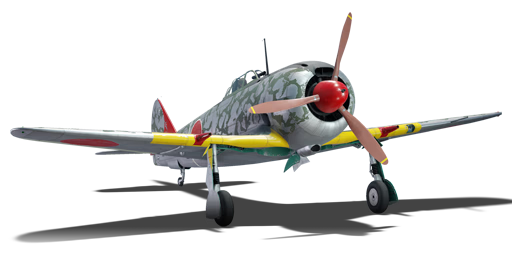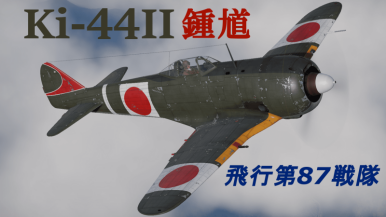



The Ki-44-II otsu, designated as the Type 2 Single-Seat Fighter, Model IIb (二式単座戦闘機一型乙), was a Model II variant of the Ki-44, featuring an improved engine and nose-mounted 12.7 mm guns. While it was equipped with only its nose armament, it could also be optionally fitted with 40 mm cannons in the wings, although these were sometimes swapped out for 12.7 mm guns due to the 40 mm’s unsatisfactory performance. The 40 mm cannons were specifically intended for countering American bombers, but despite their lethality, the Ki-44 remained an underwhelming aircraft for high-altitude interceptions against the B-29, as the cannons were effective only at very short ranges with limited ammunition—essentially at a ramming distance. This tactic was later formalised by several Army Sentai under the "Shinten Seiku-Tai" (震天制空隊) units, which used standard army planes or those stripped of armour and armament to reduce weight, enabling them to ram bombers out of the sky more efficiently. This approach was akin to the German Sonderkommando "Elbe" 's mission in 1945 and the Russian "Taran" tactics of 1941. Although survival rates were low and the attacks were effectively kamikaze missions, some pilots managed to survive multiple sorties, ramming a bomber and then ejecting to continue fighting another day.
It was introduced in Update 1.55 "Royal Armour". The Ki-44-IIb features one of the slowest-velocity cannons ever mounted on an aircraft, but the 40 mm shells pack a significant punch if they manage to hit—though this is admittedly difficult to achieve. The Ki-44-II is equipped with a powerful engine, enabling the aircraft to reach interceptor altitudes quickly and effortlessly, making it ideal for strafing bombers at high altitudes and destroying them in a single pass. Pilots should reserve their 40 mm ammunition for bombers, focusing on getting close at high speeds, as targeting smaller aircraft with these cannons presents a considerable challenge. Once the 40 mm rounds are depleted, the Ki-44-IIb can still be a formidable boom-and-zoom fighter against other aircraft, with its nose-mounted 12.7 mm machine guns providing decent lethality thanks to their high-explosive rounds.
flaps
flaps
flaps
brake
| Belt | Belt filling | Armor penetration (mm) at a distance: | |||||
|---|---|---|---|---|---|---|---|
| 10 m | 100 m | 500 m | 1000 m | 1500 m | 2000 m | ||
| HEF | 3 | 3 | 3 | 3 | 3 | 3 | |
| Belt | Belt filling | Armor penetration (mm) at a distance: | |||||
|---|---|---|---|---|---|---|---|
| 10 m | 100 m | 500 m | 1000 m | 1500 m | 2000 m | ||
| AP-T/AP/HEF-I | 21 | 19 | 13 | 7 | 4 | 3 | |
| AP-T/HEF-I/AP/HEF-I | 21 | 19 | 13 | 7 | 4 | 3 | |
| AP-T/HEF-I/HEF-I/HEF-I | 21 | 19 | 13 | 7 | 4 | 3 | |
| AP-T/AP/AP-T | 21 | 19 | 13 | 7 | 4 | 3 | |
| AP/HEF-I/HEF-I/HEF-I | 21 | 19 | 13 | 7 | 4 | 3 | |







 2 x (40 / 140 / 160) %
2 x (40 / 140 / 160) % 
 2 x 118 %
2 x 118 % 

Flight performance | |
|---|---|
Survivability |
|---|
Weaponry | ||
|---|---|---|
